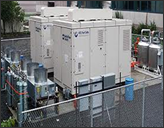Self-Generation
Generate your electricity and come off the utility grid.
There are two main reasons for coming off the grid.

1. Save money off utility electricity charges. It’s not only the commodity cost, but all of the other charges that are eliminated such as demand, transmission, distribution, etc., as well as the taxes. Look at your power bill and thnk about it.
2. Utility and grid independence. Avoid utility blackouts, brownouts & shutdowns, and have confidence your company will remain in operation, have power price certainty and peace of mind.
Cogeneration & Fuel Cell Installations
Many companies, both large and small, prefer energy independence from the local utility that these “off-grid” choices provide, as well as the greatly reduced energy costs.
Power costs are rising due to a number of reasons. Closure of coal-fired generation facilities, renewable portfolio requirements and/or carbon credit requirements all play a part. And you don’t even have to believe in “global warming or climate change” to see your rates rise, as political pressure/requirements will do that for you.
However, you don’t “necessarily have to see your electricity rates rise, as some believe.
A size for all applications: These units are designed for small usage of 30 KW for hotels, motels, and other small commercial applications such as nursing homes, gas stations, restaurants, small manufacturing plants and master metered living units all the way up to 3 or 5 MW demand for larger commercial and industrial purposes.
24/7 Operation: Systems are easily designed for operations with a 24/7 schedule, whether it be a flat a steady base load of electricity or one that is more responsive to variable levels of demand. No more waiting for the sun to shine or the wind to blow.
Costs Involved: Some smaller units are available on a NO-COST lease basis, so that a company’s energy costs are reduced immediately. In some areas there is a 50% reduction in energy costs without any out of pocket costs. Other installations have an upfront capital requirement with or without financing available and basically a 3 to 3.5 year payback. After that, the units continue to generate electricity far below utility or supplier pricing.
Fuel for Operation: Most units are fueled with clean-burning low-cost natural gas where longer term natural gas supply agreements are available in order to provide continued price certainty for both your natural gas and electricity costs. Imagine.
Ideal Candidates
The ideal candidate is one located in a utililty service area with high cost power, either in the United States or Mexico. If you can answer “yes” to any of the following questions, then you are an ideal candidate for fuel cell or cogeneration installation:
- Is your company in one of the following industries/fields?
- Manufacturing (large & small)
- Hotel/Casino Industry
- Manufacturing
- Health Care Industry
- Food Storage and Processing
- College and Universities
- Metals & Foundry Industry
- Office, Retail, Commercial
- Master-metered Living Units
- Dairy with Digesters
- Restaurant/Fast Food
- Do you have a base load electrical demand of 30 kW to 3 MW?
- Do you operate on a 24/7 (or nearly 24/7) schedule?
- Do you have use for wate heat such as boilers or heat exchangers?
Power Purchase Agreements:
A Power Purchase Agreement (PPA) is a contract between the PPA provider and the customer for the purchase of either electricity, hot water, steam, chilled water or any combination.
Manufacturers secure funding for the project, maintain and monitor the energy production, and sell the energy to the customer at a contractual price for the term of the contract. These PPA terms can range from 10 to 25 years and can be structured in a variety of ways where the customer has the options at term end. They can purchase the equipment, renew the contract, or have the equipment removed from the facility.
We will work with you to find federal and state incentive programs which can significantly offset the cost of the fuel cell, cogeneration, and/or solar installation.
Services Provided
- Turnkey Design/Build
- Feasibility Studies
- Project Management
- Installation
- Operations
- Maintenance
- Repair
- Financing
